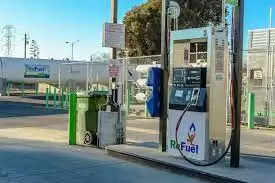Facts About CNG Production & Distribution In India
The Rising Demand for Renewable Energy: Shifting from Fossil Fuels in the 21st Century

In the 21st century, we find ourselves in a situation where there is an increasing demand for renewable energy resources instead of traditional fossil fuels. This shift has occurred gradually over time, and credit should be given to the human race for establishing industries and transportation systems reliant on petrochemical products, as well as engaging in numerous unnecessary wars to gain control over these limited natural resources.
Fortunately, the situation is now changing for the better due to advancements in technology, improved engineering practices, and scientific research. Hydro-electric projects, wind energy farms, and solar power fields are being introduced to replace existing fossil fuel power plants such as coal power plants, oil refineries, compressed natural gas, and liquid petroleum gas distribution systems.

Energy Sector Supply Agencies and Undertakings
In India, the Central Ministry of New and Renewable Energy, in collaboration with the Ministry of Petroleum and Natural Gas, has been actively involved in planning and implementing changes in the production and distribution systems. This is achieved by introducing new policies and updating existing ones in alignment with the Sustainable Development Goals outlined by the United Nations General Assembly.
The supply and distribution of petroleum products, including Compressed Natural Gas (CNG), in India are regulated by the Petroleum and Natural Gas Regulatory Board (PNGRB). The business operations are carried out through Public Sector Undertakings (PSUs) as well as private sector entities under the Public-Private Partnership (PPP) model. Companies like GAIL (India) Ltd, Brahmaputra Crackers Polymer Limited, Indraprastha Gas Limited (Mahanagar Gas Limited), Bharat Petroleum, Indian Oil, and various City Gas Distribution Entities play key roles in the distribution and business chain across India. The current government led by Narendra Modi is also encouraging increased participation from the private sector, and entities such as Adani Gas and Torrent Gas are gaining significant presence in the sector.
Authorized by the Petroleum and Natural Gas Regulatory Board (PNGRB) Act of 2006, entities are granted permission to develop City Gas Distribution (CGD) networks, including the distribution of Piped Natural Gas (PNG), within specified Geographical Areas (GAs) in the country.
The CGD sector comprises four distinct segments: Compressed Natural Gas (CNG) predominantly used as an auto-fuel, and Piped Natural Gas (PNG) used in domestic, commercial, and industrial segments.
The distribution system of CGD is divided into four main parts. It begins with the Jagdishpur-Haldia/Bokaro-Dhamra Pipeline Project (JHBDPL) and the Barauni-Guwahati Pipeline Project (BGPL), collectively known as the Central and Eastern CNG distribution line, which supplies Assam, Sikkim, West Bengal, Jharkhand, Bihar, Madhya Pradesh, and parts of Uttar Pradesh.
Next, the Northeast region (NER) gas grid covers the seven states collectively known as the "seven sisters," which include Assam, Meghalaya, Manipur, Nagaland, Tripura, and Arunachal Pradesh.
The Kochi-Koottanad-Bangalore-Mangalore (Phase-II) Pipeline Project (KKBMPL) serves the demands of the South Western Region, running from Kerala to Karnataka. The Ennore-Thiruvallur-Bangalore-Nagapattinum-Madurai-Tuticorin Natural Gas Pipeline (ETBNMTPL) forms the distribution line for the Eastern Ghats, stretching from Karnataka to Madurai.
Pre and Post GST Time Comparison
The central government is urging states to keep the value-added tax (VAT) rates on compressed natural gas and liquefied natural gas (CNG/LNG) below 5%. Additionally, the government is advocating for reduced road taxes on CNG/LNG vehicles by states to align them with the rates applied to electric vehicles (EVs).
These proposals are part of the draft city gas distribution (CGD) policy formulated by the Ministry of Petroleum and Natural Gas (MoPNG). The government expects this policy to serve as a benchmark for states to develop their own CGD policies.
Previously, different states had varying VAT rates on CNG prices. For instance, while Delhi exempted VAT on CNG, Uttar Pradesh, Maharashtra, and Gujarat charged rates as high as 12.5%, 13.5%, and 15% respectively before the introduction of the GST bill.
Experts believe that establishing a uniform tax rate for CNG would address the longstanding demand for including gas within the scope of the Goods and Services Tax (GST). Deepak Mahurkar, partner at PwC, remarked that rationalizing VAT rates and making them uniform would facilitate this much-awaited reform.
A former draft policy indicated that the government would form committees led by chief secretaries in each state, which would meet at least once every three months to assess CGD network development. These committees would collaborate with local and civic bodies to streamline clearance processes and standardize levies and charges. The central government also suggested that state-level committees should prioritize policies promoting CNG and LNG as preferred fuels for public transportation.
Obtaining licenses and work permits from various civic agencies, including land-owning agencies, municipal corporations, district magistrates, and fire departments, poses a significant challenge to expanding the CGD network.
Currently, the CGD network covers 232 geographical areas across 407 districts in 27 states. Gas accounts for 6.2% of the country's energy basket, and the goal is to increase it to 15% by 2030. As of September 2019, there were 1,815 CNG stations and 54.2 lakh domestic connections nationwide.
The majority of CNG stations (76%) and PNG connections (80-90%) are concentrated in Delhi, Gujarat, and Maharashtra.
During the ninth and tenth rounds of bidding for CGD networks in 2019, it was anticipated that the number of CNG stations and domestic PNG connections would increase by 8,181 and 4.2 crores respectively over the next 8-10 years.
CGD network operators are expected to benefit from the global decline in LNG spot prices and a projected decrease in domestic gas prices. According to Kotak Institutional Equities, CGD companies source approximately 15% of their domestic gas requirement from the Panna-Mukta-Tapti (PMT) fields.
Declassified reports indicate that after the expiry of the PMT's production sharing contract in December 2019, gas from the field was priced at $3.6 per million British thermal units (mbtu), compared to the earlier contracted price of $5.7/mbtu. This has led banking sector players like Kotak to anticipate a decline of around $1/mbtu in the upcoming revision of domestic gas prices for the first half of FY21. Private sector entities such as Adani Gas and Torrent Gas have a significant presence in this sector.
Russia Ukraine War Context:
The ongoing Russia-Ukraine conflict has had repercussions on prices and disrupted the supply and demand dynamics both within the country and globally. Additionally, since April 2022, there has been a noticeable coal crisis. The global prices skyrocketed due to rumors of China and the Kingdom of Saudi Arabia partnering to establish an oil refinery in March, which had an immediate impact on India. It remains to be seen how the CNG distribution system, along with the Ministry of Petroleum and Natural Gas and the Ministry of New and Renewable Energy, will respond to these developments and address the consumption of natural gas.



